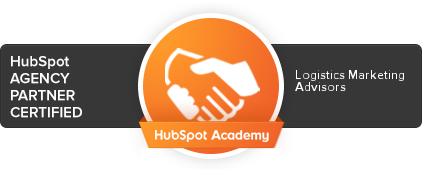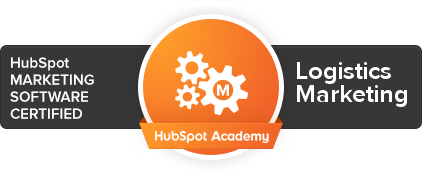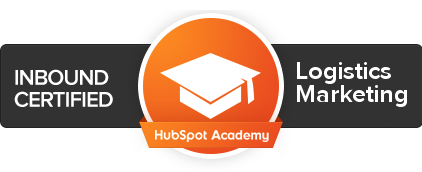The way buyers purchase high-value logistics products and services has changed dramatically in the last 10 years, but too many logistics businesses haven’t adapted their marketing and sales efforts to reflect how today’s logistics decision makers buy.
Marketing has become a game of Hide-and-Seek – but in reverse.
Logistics businesses are no longer “it,” trying in vain to find prospects that are hiding and don’t want to be found. You’re the one being sought – whether you know it or not. But in another twist on the traditional game, you WANT to be found.
The old-school approach of service provider as hunter doesn’t work. Buyers have many tech-aided ways to avoid being annoyed and interrupted by unsolicited cold calls and emails. And they get a lot of them – up to 10 a day according to our survey research with logistics buyers.
They block your calls and emails not because they don’t have problems that need solving; they just don’t have the bandwidth.
How do they get the information on how to solve logistics challenges and who can help?
The same way you and I do. The hit up Google, they talk to colleagues, they seek advice from consultants. In short, they do their research to arrive at a short list of companies that seem to have the best answer for the specific problem they’re trying to solve.
To win in this new reverse game of Hide-and-Seek, you have to become great at getting found.
Buyers are smarter than you think
 You need to believe that a smart buyer is your best prospect.
You need to believe that a smart buyer is your best prospect.
Weeks and months of due diligence tends to lead logistics buyers to the right answer, and the right set of potential providers.
If you have a great solution to the problem they are looking to solve, then today’s research-intensive buying journey, in theory, is designed to deliver them to your doorstep.
But buyers are not omniscient. They need clues. That means you need to lay a very well-orchestrated breadcrumb trail to make your company easy to find.
Let’s say the logistics lead at a fast-growing eCommerce brand has outgrown his order fulfillment partner and is anxious to find a new provider to support growth. He comes across an eBook you wrote on scalable fulfillment solutions…and the next week hears your VP on a Podcast on order fulfillment strategies…then he receives an email promoting a video case study on your fulfillment solution for another well-known etailer.
Those are the clues the buyer needs in our reverse game of Hide-and-Seek. What’s the common denominator to all of these tactics? They all represent content created to help buyers looking to solve a problem.
They say helpful is the new sexy in marketing. Believe it.
Figure out what problems you can solve better than anyone else, and then focus on helping. Look for opportunities – through the media, through your own website and social platforms, and through networking – to share your company’s expertise without hawking a product. In that way, you create demand for your solution without overtly selling.
Content is the new marketing currency. The more of it you have, the clearer the breadcrumb trail and the more people who will find you and buy from you.
CEOs are asking the wrong questions about sales growth
Most CEOs don’t see demand generation in this way. They see it as more of a sales job and, in fact, often ask their top sales executive to lead marketing and lead generation. Big mistake.
When grilling their CCOs on future growth, the questions they typically ask are:
- What prospects are we targeting?
- What industry niches are we going after?
They still think their company is “it” in the game of Hide-and-Seek. It’s a predator-prey mentality that doesn’t work.
Want to fail at fishing? Identify an area with lots of fish and then jump in the water and try to catch a few. Want to succeed? Drop a line with a tasty worm at the end.
Here are the growth-related questions enlightened CEOs should be asking:
- What problems do we solve better than anyone else?
- For these solutions, what are we doing to share our insights and expertise with the world?
Logistics products and services are BOUGHT, not SOLD. Buyers with a problem are searching for answers – across the web and across their contact networks. To get found during this search, you need to build a marketing engine designed to attract, not solicit.
If you’re hiding and buyers are seeking, you might wonder why you shouldn’t just save time by jumping out from behind the bush and saying “here I am!” Well, two reasons.
One, in a regular game of Hide-and-Seek, you know who’s “it.” But not in our backwards version. At any given time, you don’t know who’s out their searching for answers to a logistics challenge you can solve.
The second reason is more psychological. Today’s buyers hate to be sold. On the other hand, they love to buy, and they have a strong sense of confidence in that purchase decision when they’ve done the research and found, for themselves, truly good-fit partners.
When getting found is the priority, it’s best to think of yourself not as a sales person but as a guide – patiently helping prospects navigate a difficult challenge, and sharing insights along the way.
Getting Found Starts with Strategy
OK, so if you buy into the premise that marketing success is about getting found, then how do you start moving in the right direction?
It starts – first and foremost – with having a clear, differentiating value proposition.
There’s a lot of sameness in the logistics space. Lots of providers doing the same thing in the same way in pursuit of similar objectives. But if your message is the same as your competitors, good luck getting found.
Let’s say a prospect says: “Tell me about your company.” Here are two responses, both describing the same company:
- “We offer comprehensive logistics services to make your business more efficient and increase customer satisfaction.”
- “We help mid-sized retailers in the US transform their omni-channel distribution operations to compete and win against the largest competitors.”
The second purposely targets the niche market, and the challenge, that aligns best with the provider’s strengths. CEOs of logistics businesses often wrongly assume that the more general the value promise, the bigger the potential market. In fact, that’s just a recipe to remain invisible. It’s the equivalent of running into the woods with a camouflage outfit. You’re making it harder for prospects to find you.
For logistics businesses, getting market positioning right needs to be a corner-office priority and, frankly, it’s not. Executives at logistics businesses generally struggle with marketing and positioning strategy.
Don’t determine your company’s market positioning by looking in the mirror and describing what you see. You have to look at it from the outside in. When you change your perspective and see things from the prospects’ point of view, you realize that, to them, the market for your services looks like a Where’s Waldo illustration. Busy and confusing, with lots of providers who look and sound exactly the same.
If your market positioning doesn’t make it easy for prospects to recognize your unique value, the job of getting found becomes that much harder. If, by chance, you should make it to the buyer’s short list, your default differentiator becomes price.
Content is King
If you know the market you are targeting and have a powerful market positioning, the next step is to lay that breadcrumb trail that makes you that much easier to find.
That involves creation of content.
What kind of content? Well, start with the pain points your business is best able to address, then answer the questions prospects are asking about this issue. If eCommerce fulfillment is the challenge, they could be asking any number of questions:
- “How many fulfillment warehouses do I really need?”
- “Should I invest in warehouse automation to reduce labor costs?”
- “What does order fulfillment cost?”
Your sales team should have a good idea of the questions on prospects’ minds. Brainstorm those topics and create an editorial calendar of blog articles, eBooks, videos, social posts and other communications to create and publish.
What volume of content should you aim for? Well, the more breadcrumbs you lay, the more find-able you become. To start, commit to content marketing on a small scale and measure the impact on website visitors and leads. If it’s working, double down for the best results.
Content marketing is not a new strategy, so there’s a lot of content out there already. But much of it is mediocre, at best. The best content provides sharper and more provocative insights – and for that you’ll need input from your best thinkers.
One challenge is that these are the very people who are most in demand from sales and customers. That’s not a reason to opt out of participation. If growth is a company priority and if getting found is the means to that end, then a successful content strategy must involve your best subject matter experts (SMEs).
These SMEs don’t have to create the content. The marketing and communications team can handle that. But they do need to invest the time to share their knowledge with the content creators. To ensure participation, the boss may need to communicate to the team why content is an organizational priority.
The nice thing about content is that it can and should be repurposed in lots of ways. Just one input session from a SME can be turned into a blog post, a social post, a video, a PR pitch, an email, a newsletter article, and other communications.
Where to Allocate Dollars?
This game of Hide-and-Seek-in-reverse applies more if you’re selling a higher-value product or service with a long sell cycle. In such cases, you’ll need to invest more money to create and share great content. That means a higher ratio of marketing dollars vs. sales. If the challenge is more about chasing freight, then more sales people could be a better use of limited funds.
For high-value services, you want to spend more money to get found. Let marketing create the demand and let sales focus 100% on following up on warm leads and building relationships. The sales team will certainly be working their own network of contacts and referral sources. But inbound leads should supplement these efforts and eliminate the need to call cold prospects you don’t know.
There should always be a certain amount of direct marketing and selling to your very best prospects. For instance, if you’re a trucking company hauling a lot of freight from Chicago to Kansas City, you should target companies that can benefit from backhaul rates from KC to Chicago. No need to wait for them to find you. Go get ‘em. Logistics buyers are very open to outreach from providers that have done their research and come to the table with an answer to a specific problem.
Still, getting found should be your budget priority for demand generation and growth. And that doesn’t come cheap. It takes skill and resources to create a great inbound marketing engine. You’re going to need to hire people to do that for you – either by building or expanding your marketing department or partnering with an agency that has successfully implemented the strategy for other logistics clients.
Remember, it’s an investment, not an expense. More money is OK if there’s a commensurate return. Your marketing engine should include a CRM system that tracks how new customers found you originally to help calculate an ROI.
How long does it take to generate an ROI? Content marketing takes a little time to gain traction. Maybe 3-6 months depending on how aggressive the program is. After that, the length of your sales cycle will determine when you can start assessing sales revenue against marketing investments.
Getting Found: A Mindset Change
In a game of Hide-and-Seek, being “it” carries with it a sense of control. The ball’s in your court to seek and find.
When you flip that and assume the prospect is “it,” you’re then waiting to be found. That’s got a different feel – one that might not sit right with a sales leader used to being on the offensive.
But do you have a choice? Buyers have already made it clear they’re not interested in generic come-ons from people they don’t know. They’re doing their own research and finding best-fit partners. You’re either getting found during that process, or you’re not.
Getting found is anything but a passive activity. Success requires aggressively creating and publishing a steady stream of content. You’ll be busier than you would be with an outbound, sales-driven approach, and the activity will shift from selling to helping. You’re trusting that buyers searching for answers will find you because you have the right solution, and you’ve left a clear breadcrumb trail.
New customer relationships, like new friendships, grow over time. Ideally, customer and supplier, like friends, choose each other. We need to learn how to be patient and let that happen. It’s a lot like dating. If you come across as desperate, you’ll scare people away.
Park the hard sell approach and focus simply on helping. Create valuable content that helps your best prospects solve their toughest challenges.
When you build and share useful, provocative content based on your expertise and an authentic desire to help prospects succeed, you’ll be surprised at how many people find you – and buy from you – in the process.








